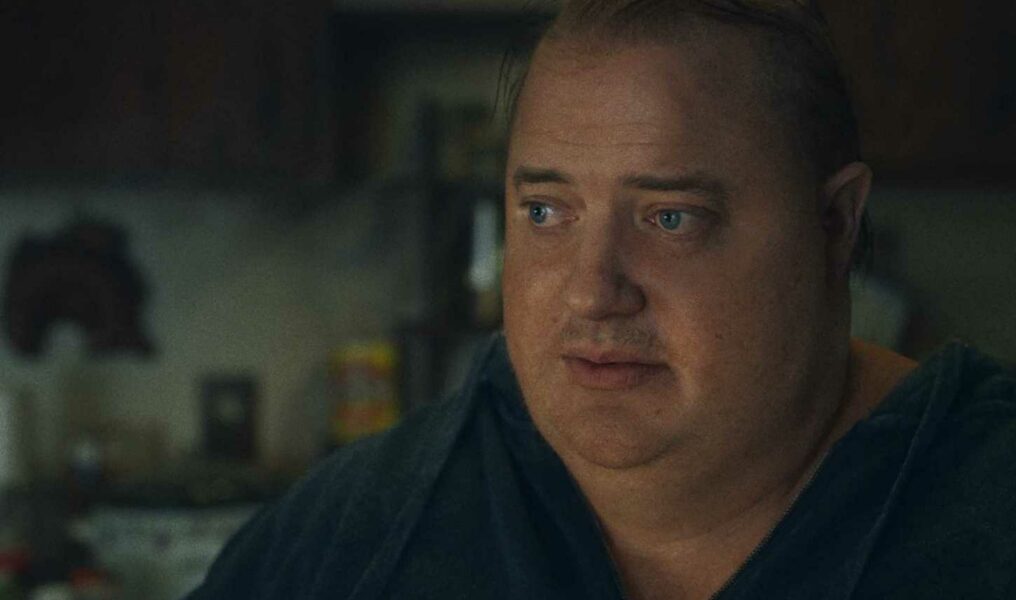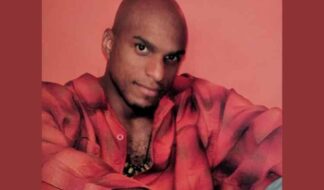From One Whale to Another: Watching ‘The Whale’ as a Fat Queer Man
Why writer Sean Donovan wanted more for Brendan Fraser's gay character

When Brendan Fraser’s character Charlie first appears in director Darren Aronofsky’s new film “The Whale,” he is masturbating to gay porn. Shown first as an anonymous shape sitting on a couch, Charlie is circled by the camera tentatively, as if it’s afraid to approach him too quickly, a reticence that is hard to distinguish as a fear of what Charlie is doing or a fear of what Charlie is.
Regardless, a fear it is, in a film where the dominant emotion alternates between slightly removed shock and condescending sympathy. But this entanglement at the center of the film’s representation leads one to ask: gay or fat, what’s the “shocker” here? Which one is shocking, and which one is the provenance of patronizing faux concern?
Charlie weighs roughly 600 pounds, we are told in the film, and in his physical condition is largely housebound, confined to a small apartment in Idaho where he teaches a writing composition class online. The entirety of the film takes place inside this apartment, a sign of its origins as a play. It’s a device intending to place the viewer in Charlie’s solitary life, interrupted intermittently by visits from his best friend and unofficial nurse Liz (Hong Chau), his estranged daughter Ellie (Sadie Sink), ex-wife (Samantha Morton), and a Christian missionary (Ty Simpkins).
“The Whale” has attracted publicity and interest as a comeback vehicle for Fraser, a heartthrob in the ’90s and early 2000s who has since faded from stardom. What has acquired less media attention is the film’s notability as the rare film — one privileged to have a great deal of film festival buzz, a major Oscar-nominated director, and a boutique distributor in A24 — to focus on the life of a fat gay man, potentially opening up a community to media representation that often lacks it.
I can’t be alone in facing this kind of representation with fear. When you’re a person of one or several minoritarian identities, seeing a film or television show allegedly “about” someone like you can be a discomforting process of coming face to face with how you are seen in the imaginations of others. Any excitement you had to “feel seen” stands to be outweighed by the disappointment of finding loaded misrecognitions in its place.
Unfortunately, my experience watching “The Whale” was more of the latter. There I sat in the theater, one whale watching another, hoping to find just a trace of connection between the two of us. Instead Fraser’s Charlie, in a fat suit and layers of prosthetic makeup, feels overcome by the baggage of a world doubly homophobic and tyrannically favoring thin body shapes, rendering the actual lived reality of a fat gay man somewhat sketchy and unconvincing, his consciousness written by belief systems that seek to destroy him.
As a fumbling, awkward teenager, much of my life was defined by keeping my queer sexuality a secret at all costs, scared enough of the straight world around me that, even without a direct threat of physical violence to me personally, I simply couldn’t imagine what a livable queer adulthood would look like. I was in an uneasy purgatory adolescence, seemingly awaiting nothing but gay hell (incidentally, great nightclub idea).
An image that sticks out to me now is from the TV series “Glee,” the first season of which aired in my senior year of high school, when the closet was becoming truly unlivable and I was starting to stick limbs out of it in a confused, furtive panic. Chris Colfer’s character, the young, starchy twink Kurt Hummel, was living a queer life, in all its challenges and pain, as well as its joys and validations.
The show was allegedly inspiring people — theoretically this could have provided a life raft for a young queer! But I looked at Kurt — trim, fashionable, small, cute — and I saw only new layers of blockages that prevented me from imagining a queer life. Sure, someone like Kurt could be gay. So could the fleeting other images I saw — predominantly white men, if not small and twinky like Kurt then chiseled and muscular with an athletic physique, like the pack of men on “Queer as Folk.” But my body, my fatness, seemingly prevented me from finding a legible queer identity. My self-love and healthy self-image has soared since, but the vulnerabilities of queer adolescence are grave and formative.
Brendan Fraser played the kind of beefcake beauty I felt impossibly distant from in the 1998 film “Gods and Monsters,” a biopic of the gay 1930s horror filmmaker James Whale — another gay whale! — deliciously played by Ian McKellen. Fraser’s character Clayton Boone, Whale’s gardener, is certainly curious about his boss’s taboo flirtatiousness with him, when the film’s 1950s setting makes such flirtation criminal. Throughout the film we see Clayton re-conceptualizing his own physicality through Whale’s eyes, learning a new rhetoric of his own desirability that begins to excite him. I wish this openness to being desired existed for Fraser some 25 years later.
Fraser’s casting in “The Whale” — and his own body’s changes, not to the extent of 600 pounds but still weight beyond what mainstream Hollywood finds acceptable in a leading man — lends precious poignancy to the film, buoyed by Fraser’s sparkly eyes and light charisma evocative of his time as himbo par excellence in “George of the Jungle.” I do believe that Fraser, who came forward as a victim of sexual assault in 2018, has a deep and sincere awareness of the troubled politics of existing in a body in this world, as it changes through different shapes of variable desirability, and as it is exposed to violence.
But Charlie the character’s body rarely coheres as a lived-in body on screen at all, and it’s not just because of the hotly debated fat suit. Sweat stains on his shirts look more like aestheticized ink blots than the signs of a real, sweating person. When the film shows its cards as a story of depression and grief, Charlie’s obesity a manifestation of his negative emotions, it begins to feel jarringly vague, the man more of a metaphor with arms and legs than a human.
What realities are left unexplored when fat bodies like his stand as signposts for ideas rather than the bearers of complicated lives? The film is at its best when it slows down to capture Charlie’s daily routines, taking note of the difficulties a man of his size encounters, and the strategies he’s employed to get around them. Otherwise, “The Whale” resorts to an assemblage of slurring wet mouth sounds as we watch Charlie eat. Overwrought music cues emphasize how very pathetic the poor man is, living out a hopeless life both shocking and saddening.
Charlie is characterized as a saint and martyr, passively taking the beating of a brutal life. Not every film needs to be a story of joy — certainly people both queer and morbidly obese have more than their full share of tragedies that are worth exhuming and processing through storytelling. But the one-note nature of the film crafts a very limited picture of what the filmmakers think a body like Charlie’s is even capable of feeling.
The ticking clock generating tension in “The Whale” is a health emergency. Charlie’s showing signs of congestive heart failure, with a deeply troubling blood pressure ratio. Despite all this, Charlie refuses to go to a hospital. The reasons for this refusal eventually become clear as part of the film’s soap opera plotting, revolving around interpersonal secrets hidden and revealed, in a perfect example of the film’s failure to generate meaning and nuance out of Charlie’s identities as both a fat and gay man.
Hospitals are not neutral spaces for fat or queer people. Frequently they are places of immense judgment and mockery. Despite efforts to change, healthcare offices for many are reminders of what kinds of bodies and sexualities are most comfortably in tune with dominant patterns of social life. Like every other fat and/or queer person I know, I have had doctors diminish unrelated health concerns due to my fatness (“You just need to lose weight”) and stumble awkwardly over my sexuality in advice about sexual health and wellness. The shame felt in medical spaces is a real danger to queer and fat populations, causing us to avoid them precisely when they are the most needed. These contexts never come up in “The Whale,” to its detriment, as they could have invested the film with the breath of true challenges and barriers facing queer and fat people in the world.
In the play upon which “The Whale” is based, scenes end with the sounds of splashing waves, in reference to the essay on “Moby-Dick” Charlie continually clings to as an example of superlative writing, and in his own existence as a large, doomed animal. Perhaps too theatrical for film, this fantastical gesture is replaced with rain pouring down on Charlie’s apartment, keeping the same water-drenched vibe, but by more realistic means. The play’s version, as small a gesture as it is, allows us to imagine just for a moment whales as figures of serenity, even grace — not aberrations incompatible with their landscape. Large, majestic creatures, the kings and queens of the oceans!
Fat gay men have spent many years, dating to at least the 1970s, if not earlier, using bears as a cultural symbol, identifying not just with their large hairiness but their cuddly appearance, an animal comparison born of affection and warmth. I wonder what this film could have been had it embraced the whale. Media’s ability to conjure new possibilities of ways to be queer in this world can and should encompass a mode of being a fat queer defined not by the fear and shock of outsider’s eyes, but an embracing of self and body. I think Charlie deserves it.









